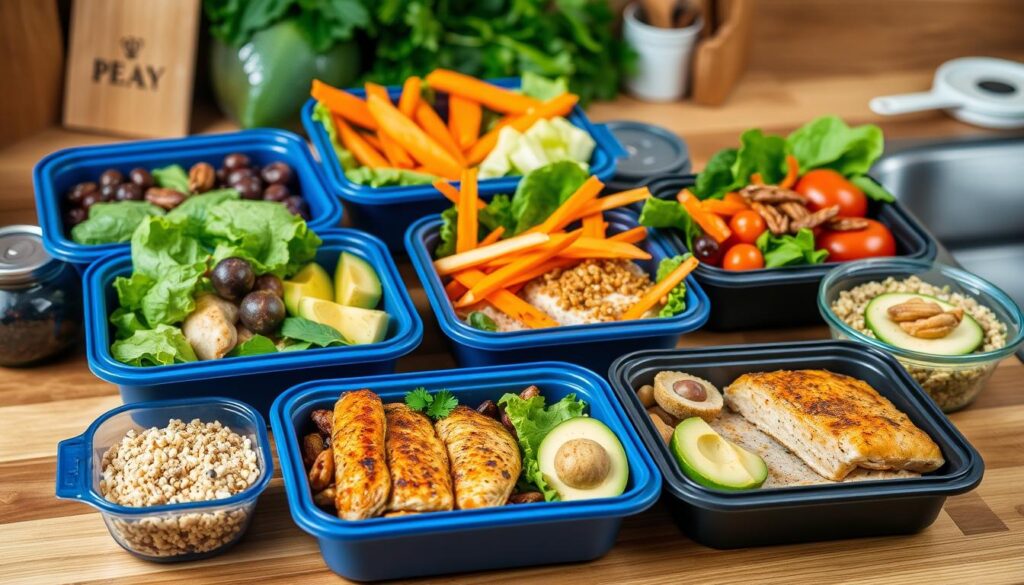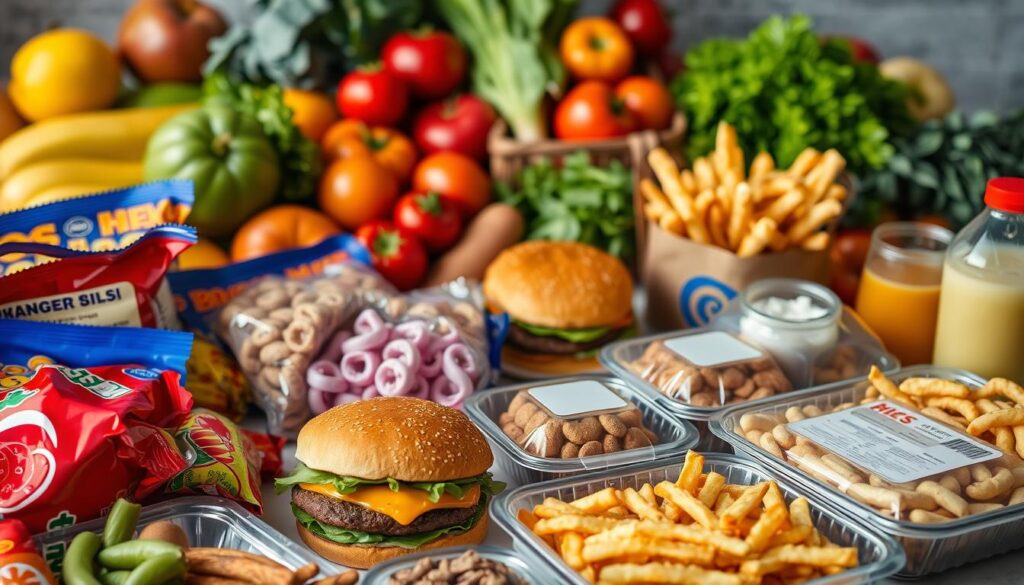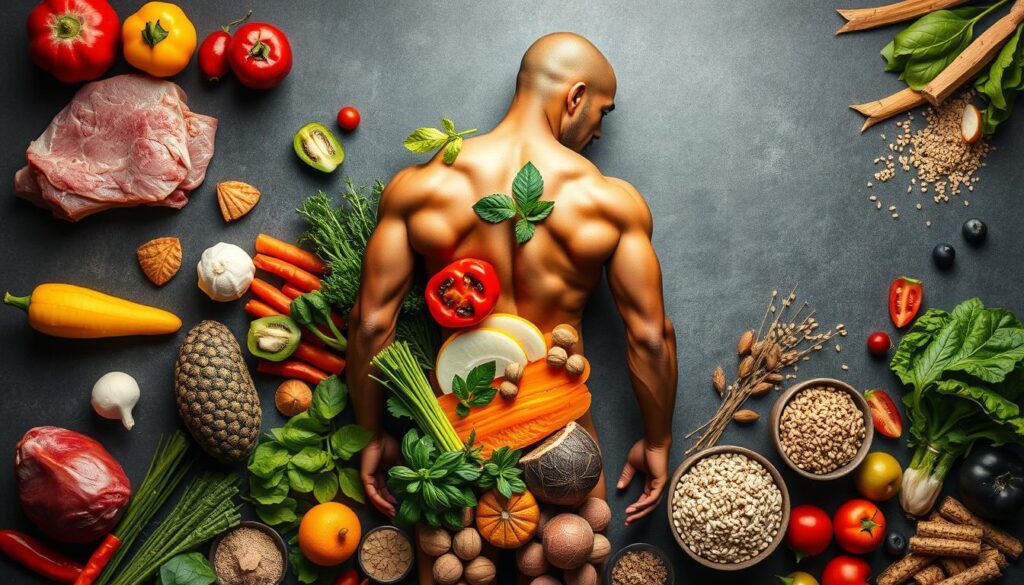Are you ready to change your body and get the look you’ve always wanted? The Burn Fat and Build Muscle Diet Plan is here to help. It’s all about losing fat and gaining strong, lean muscle. You’ll learn how to eat right to lose fat and grow muscle.
This diet plan is based on body recomposition. It’s about losing fat and gaining muscle. This makes you look and feel better, boosts your health, and speeds up your metabolism. Eating the right foods and keeping a calorie deficit will help you get lean and toned.
Key Takeaways
- Body recomposition focuses on reducing fat and building muscle simultaneously
- A calorie deficit is essential for fat loss, while prioritizing protein supports muscle growth
- Whole, nutrient-dense foods like lean proteins, complex carbs, and healthy fats are key
- Intermittent fasting may help preserve lean muscle mass when combined with resistance training
- Tracking your progress and adjusting your diet as needed is crucial for optimal results
Understanding Body Recomposition: The Science Behind Fat Loss and Muscle Gain
Body recomposition means losing fat while keeping or growing muscle. It needs a smart plan for food and exercise. Knowing how it works can help you get a toned physique and a revved-up metabolism.
What Happens During Body Recomposition
Your body changes a lot during body recomposition. You want to lose fat but keep or grow muscle. This happens with a calorie deficit, lots of protein, and strength training.
By eating fewer calories and doing strength exercises, your body uses fat for energy. At the same time, it keeps and grows lean muscle.
Benefits of Body Recomposition
- Improved metabolic rate: As you build muscle, your body burns more calories, even when you’re not moving.
- A more toned, defined physique: Losing fat and keeping muscle gives you a sculpted look.
- Sustainable weight management: This way of losing weight is a lifestyle, making it easier to keep the results.
Setting Realistic Expectations
Body recomposition takes time, months or even years. It’s key to have realistic goals and be patient. Don’t try extreme diets or quick fixes.
They can harm your muscle preservation and metabolism. Instead, build healthy habits that support your body’s change.
Calculating Your Ideal Caloric Intake for Success
To find your ideal caloric intake, first, figure out your maintenance calories. These are the calories your body needs to stay at your current weight. This number is key to adjusting your calories for your goals.
The 2020–2025 Dietary Guidelines say most females need at least 1,600 calories a day. Males might need 2,000 calories. But, these numbers can change based on your age, how active you are, and your body type.
To find your maintenance calories, use an online calorie calculator. It will look at your age, gender, height, weight, and how active you are. The Mifflin-St Jeor equation is a good starting point.
Once you know your maintenance calories, you can adjust them to reach your goals:
- For bulking (gaining muscle), add 15% more calories than you need.
- For cutting (losing fat), cut 15% from your maintenance calories.
Keep an eye on your weight and body changes. Adjust your calorie targets as needed. Aim for a slow weight change of 0.5-1% of your body weight each week. This helps keep muscle while losing fat or gaining muscle.
| Goal | Calorie Adjustment |
|---|---|
| Maintenance | Consume the same amount of calories as your body needs. |
| Bulking | Increase calories by 15% above maintenance. |
| Cutting | Decrease calories by 15% below maintenance. |
By carefully calculating and adjusting your maintenance calories, you’ll be on your way to your bulking or cutting goals. Stay consistent and patient. With the right plan, you can reach your body and performance goals.
Essential Macronutrient Ratios for Optimal Results
To reach your body goals, knowing the right mix of nutrients is crucial. The best mix for losing fat and gaining muscle is 30-35% protein, 55-60% carbohydrates, and 15-20% healthy fats. Let’s explore why each is important.
Protein Requirements for Muscle Growth
Enough protein is key for muscle building. Aim for 1.2-2.0 grams of protein per kilogram of body weight. Adjust this based on how active you are and your body goals.
Carbohydrate Balance for Energy
Carbohydrates give you energy for workouts and daily life. Choose complex carbs from whole foods to help with fat loss and muscle gain. Aim for 55-60% of your calories to come from carbs.
Healthy Fats for Hormone Production
Getting the right amount of healthy fats is vital for hormone health. Aim for 15-20% of your calories from fats like avocados, nuts, seeds, and olive oil. These fats support hormone balance, which is key for muscle growth and fat loss.
For your specific needs, talk to a registered dietitian or certified nutritionist. They can craft a diet plan that fits your body goals and activity level.
| Macronutrient | Recommended Range |
|---|---|
| Protein | 1.2-2.0 g/kg of body weight |
| Carbohydrates | 55-60% of total daily calories |
| Healthy Fats | 15-20% of total daily calories |
“Precise macronutrient tracking is essential for effective body recomposition. It allows you to fine-tune your intake and make targeted adjustments to achieve your desired results.”
Burn Fat and Build Muscle Diet Plan: Your Complete Guide
Creating a diet plan for burning fat and building muscle is about finding the right mix. You need to eat foods rich in nutrients and control your portions. This way, you fuel your body for top performance and to change your body shape.
First, plan your meals ahead of time. This way, you can pick the best foods and avoid bad choices. Make sure each meal has a lean protein, complex carbs, and healthy fats. This mix keeps you full and gives you energy all day.
Be careful with how much you eat. Use small plates and eat slowly. Listen to when you’re hungry or full. Stick to a routine, but let yourself have one cheat meal a week. This keeps you motivated.
| Nutrient-Dense Foods for Muscle Growth and Fat Loss | Portion Control Guidelines |
|---|---|
|
|
By using this balanced meal planning method, you’re on the right path. Stay consistent, listen to your body, and enjoy the journey of changing your body.

“Consistency is the key to success in any fitness or nutrition plan. Embrace the journey and celebrate your progress, no matter how small.”
Best Foods to Support Muscle Growth and Fat Loss
To get the body you want, you need a good diet plan. Focus on foods that help grow muscles and lose fat. Let’s look at the best foods for your meals.
Lean Protein Sources
Protein is key for muscle building. Eat lean meats like chicken, fish, and beef. Tofu and legumes are good for plant-based diets. Aim for 1.4–2 grams of protein per kilogram of body weight daily.
Complex Carbohydrates
Carbs like sweet potatoes, quinoa, and oats give you energy. They also have fiber to keep you full. These foods are great for your workouts and overall health.
Healthy Fat Options
Healthy fats from avocados, nuts, and olive oil are important. They help with hormone production for muscle and fat loss. Make sure to eat a variety of these foods.
Add colorful fruits and veggies to your diet. They give you vitamins, minerals, and antioxidants. Greek yogurt and cottage cheese are good for protein and calcium.
| Nutrient-Rich Foods | Protein (g) | Carbs (g) | Fat (g) |
|---|---|---|---|
| Chicken Breast (3 oz) | 26 | 0 | 3 |
| Salmon (3 oz) | 17 | 0 | 7 |
| Cottage Cheese (1 cup) | 28 | 6 | 4 |
| Quinoa (1 cup) | 8 | 39 | 4 |
| Avocado (1 whole) | 4 | 12 | 30 |
Eating these foods will help you grow muscles and lose fat. This is key for a successful body transformation.
Foods to Avoid During Your Body Transformation
If you want to burn fat and build muscle, watch what you eat. Some foods can slow you down. So, it’s smart to cut back or avoid them.
Processed foods are a big no-no. They have lots of added sugars, bad fats, and preservatives. Snacks like chips, cookies, and crackers should be rare.
Alcohol is another thing to limit. A little drink is okay, but too much can hurt your goals. It has a lot of calories and messes with your hormones.
- Reduce or eliminate processed and fried foods
- Limit intake of added sugars, found in candies, sodas, and baked goods
- Moderate your alcohol consumption to support muscle building and fat loss
Eating whole, healthy foods and cutting back on bad ones will help you transform your body. Remember, it takes time and effort for lasting changes.

“A diet high in ultra-processed foods significantly increases the risk of overweight and obesity, as well as heart disease.”
Strategic Meal Timing and Portion Control
It’s key to plan your meals well for a better body. Eating the right foods at the right time helps you work out better and lose fat. It also helps you keep and grow muscle.
Pre-Workout Nutrition
Eat carbs and protein before working out. They give you energy and help your muscles repair. Good choices are a banana with yogurt, oatmeal with berries and protein, or a turkey and avocado sandwich.
Post-Workout Recovery Meals
Eat protein and carbs within 30 minutes after working out. This helps your muscles recover and your energy stores get back. Choose lean proteins like chicken or fish with carbs like quinoa or sweet potatoes. Low-fat milk or Greek yogurt is also good.
Meal Frequency Guidelines
Eat 3-5 meals a day to keep your energy up and help you lose fat and build muscle. If you work out a lot, you might need snacks too. Drinking water is also important for your body.
Plan your meals well to help your body reach your fitness goals. Try different things to see what works best for you.
| Nutrient | Recommended Intake |
|---|---|
| Calories | Aiming for a caloric surplus of 300-500 calories per day is recommended to support muscle growth. |
| Protein | Consuming at least 1 gram of protein per pound of body weight daily is advised for muscle gain. |
| Macronutrient Ratio | It is suggested to get 40% of calories from carbs, 30% from protein, and 30% from fat in a muscle-building diet plan. |
Supplements to Enhance Your Results
Adding the right supplements can really help your body change. They work well with a good diet and exercise. They can help grow muscles, burn fat, and improve your health and performance.
Whey protein is a great choice. Many studies show it helps build muscles and lose fat. People who take whey protein gain more muscle and lose more fat than those who don’t.
Creatine monohydrate is also good. It helps build muscle and boost strength and performance. It’s a great addition to your supplements.
Caffeine is another helpful supplement. It reduces fatigue, improves workouts, and helps burn fat.
But remember, supplements are not a replacement for a healthy diet and exercise. Always talk to a doctor before starting new supplements. This ensures they’re right for you and your health goals.
“Incorporating the right supplements can be a game-changer in your body transformation journey, but they should always complement a healthy lifestyle, not replace it.”
Conclusion
To lose fat and gain muscle, you need to keep trying and change your lifestyle. Body changes take time and effort. Stick to healthy habits, not quick fixes.
Check how you’re doing often and change your plan if needed. Eating right, exercising, and being consistent helps a lot. Enjoy the journey and celebrate small victories.
With the right mindset and this guide, you can start a big change. It’s not just about your body. It’s about feeling better overall. Stay strong and enjoy the journey of losing fat and gaining muscle.

